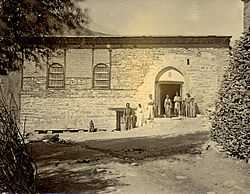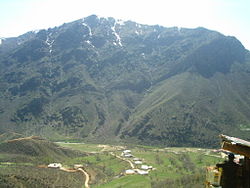- Hakkari
-
This article is about the historical region. For the Turkish city, see Hakkâri. For the province, see Hakkâri Province.
Hakkari also spelled Hakkiari, Hakari, Hakiari, etc., (Syriac: ܚܟܐܪܝ Ḥakkāri, or ܗܟܐܪܝ Hakkāri), was a historical mountainous region lying between the plains on Nineveh to the south of Lake Van,[1] encompassing parts of the modern provinces of Hakkâri, Şırnak, Van in Turkey and Dohuk in Iraq.
Contents
History
Little is known about the history of the region before Europeans first visited it in the 18th century. It is thought however that the Christian concentration dates back to the 14th century when Timurlane occupied Persia and Mesopotamia and persecuted its Christian populace driving them to the safety of the mountains. By the 16th century the Nestorians disappeared from many cities where they previously thrived, such as in Tabriz and Nisibis. The head of the Church of the East moved from Baghdad to Maragha in Urmia by 1553.[2] The Assyrians later concentrated in a mountainous triangular region with its head at Lake Van and Lake Urmia and Mosul. Thus lying in parts of Kurdistan and Azerbaijan.[2] The Church of the East lost most of its members in the few centuries following the Schism of 1552 to the Chaldean Catholic Church. Those living in Hakkari, however, were unaffected by the disputes and around 1600 the Chaldean Archbishop Shimun IX Dinkha broke away from Rome and moved to Qudshanis in Hakkari where he reintroduced the Shimun line hereditary patriarchy which continued until 1976.
The Patriarch residing in Mar Shalita Church in Qudshanis enjoys both spiritual and political power over his subjects. Since priests were required to remain celibates the patriarchy moved from uncle to nephew.[2] This system came to be known as Nāṭar Kursyā (ܢܛܪ ܟܘܪܣܝܐ "Guardian of the throne"), and by the 19th century this system was applied to all dioceses of Hakkari.[3]
The Assyrians formed intricate alliances with neighbouring Kurdish tribes and their Ottoman lords, each tribe was led by a Malik (ܡܠܟ) who also functioned as a military leader during war time.[4]
Kurdish wars
Several Kurdish competing centers started emerging in the region on the 19th century. Mir Muhammed the Kurdish Emir of Soran based in Rawanduz was able to establish a powerful emirate and depose his rivals controlling a region streching from Mardin to Persian Azerbaijan.[5] he was however defeated in battle when he tried to subdue the Assyrians of Hakkari in 1838. The Ottomans seeking to consolidate their control on the region engaged him in a costly war which led eventually to the dissolution of his Emirate.[6]
After the fall of his main rival Bedir Khan of Bohtan sought to extend his dominion by annexing the Assyrian regions in Hakkari.[7] He took advantage of a rift between the patriarch Shimun XVII Abraham and Nur Allah the Emir of Hakkari. Badr Khan allied with Nur Allah and the Assyrians of Tyari attacked the Assyrians of Hakkari in summer 1843 massacring them and taking those who survived as slaves.[8] Another massacre was inflicted in 1846 on his previous allies, the Assyrians of Tiyari.[8] The western powers, alarmed by the massacres pressured the Ottomans to intervene. Badr Khan was subsequently defeated and exiled to Crete in 1947.[8]
Direct Ottoman control
Although the region was nominally under Ottoman control since the 16th century, it was in reality administered by its Assyrian and Kurdish inhabitants and their lords. The situation changed after the Kurdish war as the Ottomans now were able to extend their full control unopposed, and in 1868 the Sandjaq of Hakkari was created.[9]
Genocide and Exodus
On the eve of the First World War patriarch Shimun XXI Benyamin was promised preferential treatment in anticipation of the war.[10] Shortly after the war began however Assyrians and Armenian settlements to the north of Hakkari were attacked and sacked by Kurdish irregulars allied with the Ottomans.[11][12] Others were forced into labour battalions and later executed.[13]
The turning point was when the patriarch's brother was taken prisoner as he was studying in Constantinople. The Ottomans demanded Assyrian neutrality and executed him as a warning.[14][15] In return, the patriarch declared war on the Ottomans on 10 April 1915.[15]
The Assyrians were immediately attacked by Kurdish irregulars backed by the Ottomans, driving most of the Assyrians of Hakkari to the mountain tops, and killing those who stayed in their villages.[15] Shimun Benjamin was able to move unnoticed to Urmia which was under Russian control and tried to persuade them to send a relief force to the besieged Assyrians.[15] When the Russians replied that the request was unreasonable he returned to Hakkari and led 50,000 Assyrians through the mountains to safety in Urmia.[15] Thousands perished from cold and hunger during this march.[15]
After the First World War
During the peace conferences in Paris in 1919, the Assyrians claimed a state in Diyarbekir and northern Mesopotamia in Iraq; others requested a British protectorate in Upper Mesopotamia, northern Mosul, and Urmia.[16] The Turks and Kurds objected to the repatriation of the Christians to their ancestral lands in Hakkari, and an attempt to occupy the region by Agha Petros failed. In 1924 Turkey formally occupied northern Hakkari and expelled the last Christian inhabitants to the south.[17]
See also
- List of Assyrian tribes
- Tyari
- Barwari
- Shemsdin (East Syrian Ecclesiastical Province)
Notes
- ^ Aboona 2008, p. 2
- ^ a b c Alexander 1994, p. 36
- ^ Wilmshurst 2000, p. 277
- ^ Aboona 2008, p. 35
- ^ Aboona 2008, p. 173
- ^ Aboona 2008, p. 174
- ^ Aboona 2008, p. 179
- ^ a b c McDowall 2000, p. 47
- ^ Aboona 2008, p. 3
- ^ Stafford 2006, p. 23
- ^ Stafford 2006, p. 24
- ^ Gaunt & Beṯ-Şawoce 2006, p. 134
- ^ Gaunt & Beṯ-Şawoce 2006, p. 136
- ^ Malik, Yusuf (1934), The Assyrian Tragedy , S. Michael
- ^ a b c d e f Stafford 2006, p. 25
- ^ Nisan 2002, p. 187
- ^ Nisan 2002, p. 188
References
- Nisan, M (2002) [1991], Minorities in the Middle East: a history of struggle and self-expression, McFarland, ISBN 978-0786413751, http://books.google.com/books?id=keD9z1XWuNwC.
- Alexander, V (1994) [1994], The First Civilization, Victor Alexander, ISBN 978-1448670895, http://books.google.com/books?id=PPbzbZo6nDAC.
- Stafford, R (2006) [1935], The Tragedy of the Assyrians, Gorgias Press LLC, ISBN 978-1593334130, http://books.google.com/books?id=LSzuzsRh37gC.
- Aboona, H (2008), Assyrians, Kurds, and Ottomans: intercommunal relations on the periphery of the Ottoman Empire, Cambria Press, ISBN 978-1604975833, http://books.google.com/books?id=AdZfWpd4YrYC.
- Wilmshurst, D (2000), The ecclesiastical organisation of the Church of the East, 1318-1913, Volume 582, Cambria Press, ISBN 978-9042908765, http://books.google.com/books?id=jB8ir0ek8bgC.
- McDowall, D (2000), A modern history of the Kurds, I.B.Tauris, ISBN 978-1850434160, http://books.google.com/books?id=dgDi9qFT41oC.
- Gaunt, D; Beṯ-Şawoce, J (2006), Massacres, resistance, protectors: Muslim-Christian relations in Eastern Anatolia during World War I, Gorgias Press LLC, ISBN 978-1593333010, http://books.google.com/books?id=4mug9LrpLKcC.
Categories:- Hakkari
- Geography of the Ottoman Empire
Wikimedia Foundation. 2010.


